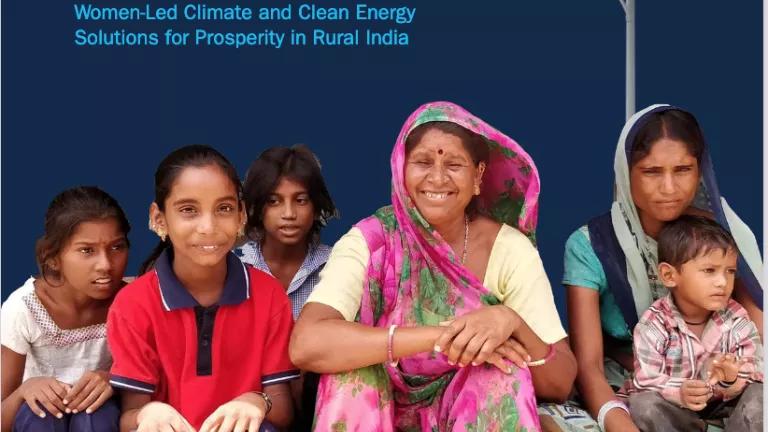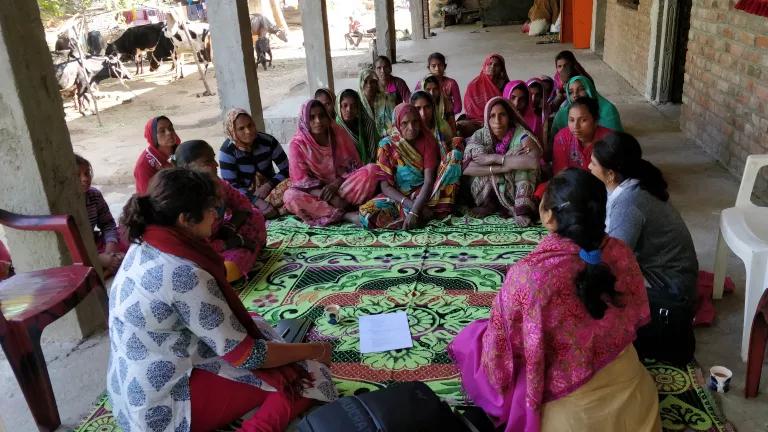Renewable Energy: A Driver for Job Growth
Our new report provides key insights on employment trends in the solar and wind energy sectors in India, as well as provides recommendations on how to best support renewable energy deployment.

Dreamstime
Co-authored with Charu Lata, Akanksha Golchha, and Akanksha Tyagi
India's recently announced Union Budget highlights green growth as one of the priority areas acknowledging that renewable energy, in addition to providing energy security and environmental sustainability, can also generate large scale employment opportunities. A new report, India's Expanding Clean Energy Workforce - 2022 Update, released today by Natural Resources Defense Council India (NRDC India), Council on Energy Environment and Water (CEEW), and Skills Council for Green Jobs (SCGJ), presents market analyses and insights on green jobs growth in India and recommendations on how to best develop the renewable energy workforce of the future. In 2022, as India’s renewable energy share increased to 29% of the total installed capacity, the solar and wind energy sectors employed 164,000 people, even as SCGJ trained 100,000 people in the renewable energy sector across the country as per findings of the report.
With a young population, creating sustainable employment opportunities is a priority for India, poised to be the most populous country in the world. As India aims to meet 50 percent of its cumulative electric power installed capacity from non-fossil sources by 2030, the clean energy sector has the potential to be a major employment hub for the country’s jobs of the future. Renewable energy jobs in general are more equitable and provide relevant opportunities for workforce participation by women. For example, programs such as the grassroots, village-level Hariyali Gram initiative, that support women entrepreneurs can create more gender-empowering livelihood opportunities. India has also recognized the importance of providing adequate and accessible green job skills. A new, fourth phase of the Pradhan Mantri Kaushal Vikas Yojana , the flagship scheme of the Ministry of Skill Development & Entrepreneurship implemented by the National Skill Development Corporation, can train lakhs of youth within the next three years with on-job trainings, industry partnerships, and alignment of courses with the needs of the industry.
Key Findings
- The solar sector added an additional 52080 people to the workforce in FY22. Capacity deployment in the solar sector registered a strong year on year growth. Utility scale solar deployment increased by 229 percent in FY22 as compared to FY21 with an annual capacity addition of 11.6 GW. This added capacity resulted in an additional 29,788 people joining the workforce in the segment. The rooftop solar segment deployed 22,292 new workers and 2.3 GW of additional capacity, a 61 percent year-on-year increase.
- The wind sector employed 556 new workers in FY22. With an addition of 1.1 GW capacity, this workforce was engaged in operation and maintenance activities and no new workforce requirement arose in other project deployment phases such as design and construction. With the Government of India setting a goal to invite bids for 8 GW of wind energy projects each year till 2030, the employment prospect of the sector is expected to increase.
- New jobs are emerging with technology advancements. The deployment of 10 MW/10 MWh standalone battery energy storage system at Tata Power-DDL’s Rohini substation directly employed 61 workers. As the renewable energy sector grows, the deployment of battery energy storage systems is expected to increase. Consequently, the employment opportunities in this domain will increase. Similarly, it is expected that the green hydrogen sector will add 0.6 million workers through the National Green Hydrogen Mission. Industrial production and engineering, robotics and automation, modelling, and data analytics are some key skills needed in the emerging sectors.
- Innovation in training delivery mechanisms resulted into more inclusive skilling efforts. SCGJ developed an e-learning management system to enable remote learning. 2,000 candidates have been virtually trained and certified through virtual instructor led trainings.
Recommendations
There is significant opportunity to combine the government’s job creation and energy transition goals. As summarized in the report, the following recommendations can help:
- Mainstream industry relevant renewable energy courses at universities for developing highly skilled workforces: Academic institutes should include industry relevant courses at higher education levels and leverage industrial connections to implement initiatives such as the National Credit Framework in order to mainstream skilling and vocational education.
- Expand existing institutional capacity at state levels for sector-centric skilling programs. State skill development agencies should track demand for green jobs, bridge skill gaps and provide continuous reskilling opportunities to improve employability.
- Create gender focused skilling courses to improve women participation in the clean energy workforce: The entire skilling ecosystem should deploy gender-specific strategies for improving these parameters. Instruments such as women trainers, online trainings, career guidance can be helpful.
- Support existing workforce in conventional energy sectors move towards appropriate career trajectories with initiatives for upskill, reskill and possibly re-certify competence. Promote inclusion of skilling programs with current schemes to ensure manufacturing, investments, and exports in the value chains.
Earlier analyses had projected that India’s solar and wind energy targets for 2030 can create about 3.4 million new jobs, which could employ one million people. Emerging sectors, including energy storage, off shore wind, green hydrogen, and manufacturing of batteries, solar cell and modules, would further create new employment opportunities and skilling requirements. India's experience in creating a green workforce will have global lessons. Addressing global skill gaps via the development of an international skill gap mapping portal for current and future markets, as well as a framework to harmonize skills and qualifications, are both priorities for India in its G20 presidency. These solutions can support the mobilization of skilled labour to bridge the demographic differences some G20 member countries face.
Reactions
Referring to the key findings of this new report, Ms. Dipa Bagai, Country Head, NRDC India remarked: “The continued growth of renewable energy jobs shows the potential to achieve multiple priorities of the Indian government, including employment generation, the expansion of clean energy and robust economic development. The country’s ambitious renewable energy targets provide an opportunity to create a more equitable workforce while transitioning to a low-carbon economy.”
“SCGJ achieved a milestone of training more than 100,000 people in the renewable energy domain in FY22. With new technologies emerging, we at the SCGJ are bolstering our efforts to ensure that more training programmes are launched in the future that are both versatile and relevant as the renewable energy sector grows,” said Dr. Praveen Saxena, CEO, SCGJ
“India’s renewable energy sector continues to grow steadily and create employment opportunities. Our earlier studies have showcased the potential to employ 1 million people in the sector as India marches towards the 2030 ambitions. The skilling programmes must catch up with the new requirements arising from sectors such as solar module and battery manufacturing and hybrid projects. Further, state-level actors have an important role to play in mainstreaming skilling programmes and taking them to the grassroots to achieve a citizen-centric energy transition.” Mr. Neeraj Kuldeep, Senior Programme Lead, CEEW
Charu Lata is a Senior Program Lead Clean Energy and Transportation, NRDC India, Akanksha Golchha is a Clean Energy Lead, NRDC India, and Akanksha Tyagi is a Program Associate, CEEW.



